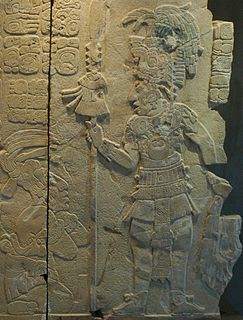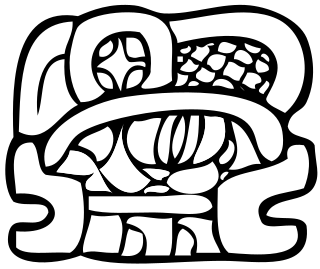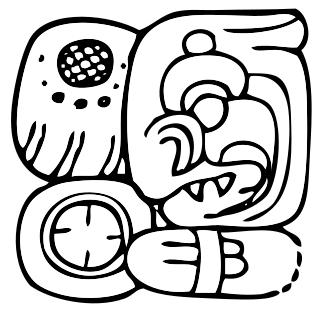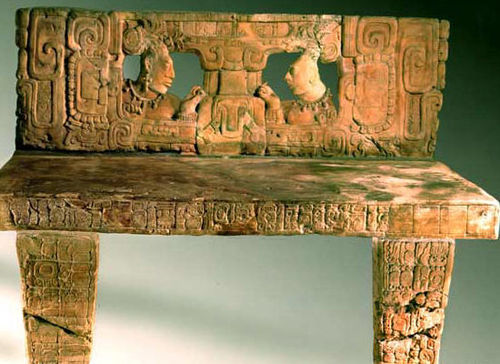
Kʼinich Janaab Pakal I (Mayan pronunciation: [kʼihniʧ xanaːɓ pakal], also known as Pacal, Pacal the Great, 8 Ahau and Sun Shield, was ajaw of the Maya city-state of Palenque in the Late Classic period of pre-Columbian Mesoamerican chronology. He acceded to the throne in July 615 and ruled until his death. During a reign of 68 years, the longest known regnal period in the history of the Americas, the 30th longest worldwide and longest until Frederick III in the 15th century, Pakal was responsible for the construction or extension of some of Palenque's most notable surviving inscriptions and monumental architecture.

Kʼinich Kan Bahlam II, also known as Chan Bahlum II, was ajaw of the Maya city-state of Palenque. He acceded to the throne in January, 684, several months after the death of his father and predecessor, Kʼinich Janaab Pakal I and ruled until his death.
Itzam Kʼan Ahk I, also known as Ruler 2, was an ajaw of Piedras Negras, an ancient Maya settlement in Guatemala. He ruled during the Late Classic Period, from AD 639-686. The son of Kʼinich Yoʼnal Ahk I, Itzam Kʼan Ahk I took the throne when he was only 12 years old. His reign was marked by several wars, and he seems to have had a special connection with Calakmul. Itzam Kʼan Ahk I died just a few days before the marriage of his son, who succeeded him as ajaw of Piedras Negras and took on the name Kʼinich Yoʼnal Ahk II. Itzam Kʼan Ahk I left behind several monuments, including eight stelae stelae, three panels, a throne, and a short stela-like column; this made him the most active of Piedras Negras's leaders in regards to erecting monuments.

Lady Eveningstar was a Maya queen consort, wife of Itzamnaaj Bʼalam II, a Maya king of Yaxchilan. Their son, Yaxun Bʼalam IV - "Bird Jaguar", succeeded his father as king.

Kʼahkʼ Pulaj Chan Chaahk, also known as Lord Chac before the decipherment of his corresponding name glyphs, is currently the only archaeologically identified ruler of the pre-Columbian Maya polity at Uxmal, who ruled in the early 10th century. Only a handful of details are known from this king, as hieroglyphic inscriptions, while very prominent in the Southern Maya Lowlands, are scarce in the north. What is known is that Lord Chac acceded to the throne somewhere at the end of the 9th century. During his rule, between 890-910 AD, some of the largest and most impressive buildings in Uxmal, such as the so-called Nunnery Quadrangle and the Governor's Palace, were built. An inscription at a large ballcourt in Uxmal, for playing the Mesoamerican ballgame, informs us it was dedicated in 901 during the reign of this king.

During the 7th and 8th centuries in Mesoamerica, there was an evident shift in the roles women played in ancient Maya society as compared with the previous two centuries. It was during this time that there was a great deal of political complexity seen both in Maya royal houses as well as in the Maya area. Warfare was a significant factor in political competition and marriage was one of the ways that alliances were made between the different polities. This was accompanied by a shift in women's roles from wife and mother to playing integral parts in courtly life, such as participating in rituals involving the supernatural world and at times ruling individual polities.

Sihyaj Chan Kʼawiil II, also known as Storm Sky and Manikin Cleft Sky, was an ajaw of the Maya city of Tikal. He took the throne on November 26, 411 and reigned until his death. He was a son of his predecessor Yax Nuun Ahiin I and Lady Kʼinich, and a grandson of Spearthrower Owl. Stela 31, erected during his reign, describes the death of his grandfather in 439; other monuments associated with Sihyaj Chan Kʼawiil II are Stelae 1 and possibly Stelae 28. Tikal Temple 33 was Sihyaj Chan Kʼawiil II's funerary pyramid and his tomb was located beneath it.
Kʼan Ahk I, also known as Ruler A was a king of that Mayan city. He is also known as Turtleshell.

Kʼan Ahk II, also known as Ruler B was the second ruler of that Mayan city in Guatemala. He was a successor of Ruler A. He reigned c. 478.

Kʼinich Yoʼnal Ahk I, also known as Ruler 1, was an ajaw of Piedras Negras, an ancient Maya settlement in Guatemala. He ruled during the Late Classic Period, from 603–639 AD. It has been proposed that he began a new dynasty at Piedras Negras, following years of ineffective kings. As to how Kʼinich Yoʼnal Ahk I came to power, a consensus has not yet been reached, although it is known that he waged several successful wars against Palenque and Sak Tzʼiʼ. He was succeeded by his son, Itzam Kʼan Ahk I, in 639 AD and left behind several monuments, including stelae at Piedras Negras and a large mortuary temple now known as Pyramid R-5.

Kʼinich Yoʼnal Ahk II, also known as Ruler 3, was a king of Piedras Negras, Maya city in Guatemala. He reigned from January 2, 687 until 729.

Itzam Kʼan Ahk II, also known as Ruler 4, was an ajaw of Piedras Negras, an ancient Maya settlement in Guatemala. He ruled during the Late Classic Period, from 729–757 AD. Itzam Kʼan Ahk II ascended to the throne following the death of Kʼinich Yoʼnal Ahk II. Itzam Kʼan Ahk II may have fathered the following three kings of Piedras Negras: Yoʼnal Ahk III, Haʼ Kʼin Xook, and Kʼinich Yat Ahk II. Following Itzam Kʼan Ahk II's demise, he was succeeded by Yoʼnal Ahk III in 757 AD. Itzam Kʼan Ahk II left behind several monuments, including stelae at Piedras Negras and a large mortuary temple now known as Pyramid O-13. In addition, the details of his life and his Kʼatun-jubilee were commemorated on Panel 3, raised by Kʼinich Yat Ahk II several years following Itzam Kʼan Ahk II's death.

Yoʼnal Ahk III, also known as Ruler 5, was an ajaw of Piedras Negras, an ancient Maya settlement in Guatemala. He ruled during the Late Classic Period, from 758 to 767 AD. Yoʼnal Ahk III ascended to the throne upon the death of Itzam Kʼan Ahk II, who may have been Yoʼnal Ahk's father. He was succeeded by his probable brother, Haʼ Kʼin Xook in around 767 AD. Yoʼnal Ahk III left behind two surviving stelae at Piedras Negras, namely Stelae 14 and 16, the former of which has been called one of the finest niche stelae, according to Simon Martin and Nikolai Grube.
Kʼan I was a Maya king of Caracol in Belize. He reigned AD 531-534.

Yajaw Teʼ Kʼinich II was a king of the Mayan state Caracol in Belize. He was also known as Ruler III, Lord Water and Lord Muluc and reigned AD 553-593>.

Haʼ Kʼin Xook, also known as Ruler 6, was an ajaw of Piedras Negras, an ancient Maya settlement in Guatemala. He ruled during the Late Classic Period, from 767–780 AD. Haʼ Kʼin Xook was a son of Itzam Kʼan Ahk II, and he ascended the throne following the death of his brother, Yoʼnal Ahk III. Haʼ Kʼin Xook's reign ended with either his death or his abdication in favor of his brother Kʼinich Yat Ahk II; archaeologists and Mayanists have not arrived at a clear consensus. Haʼ Kʼin Xook left behind several monuments, including stelae at Piedras Negras and a stone fragment from El Porvenir. In addition, a stone seat known as Throne 1 and erected by Kʼinich Yat Ahk II records either the death or abdication of Haʼ Kʼin Xook.



























